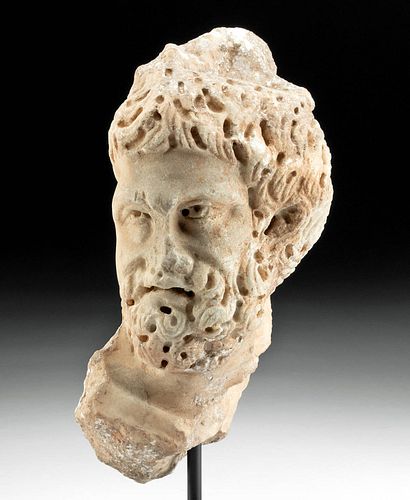Roman Marble Relief Fragment - Head of a Bearded Man
Lot 43a
About Seller
Artemis Fine Arts
686 S Taylor Ave, Ste 106
Louisville, CO 80027
United States
Selling antiquities, ancient and ethnographic art online since 1993, Artemis Gallery specializes in Classical Antiquities (Egyptian, Greek, Roman, Near Eastern), Asian, Pre-Columbian, African / Tribal / Oceanographic art. Our extensive inventory includes pottery, stone, metal, wood, glass and textil...Read more
Estimate:
$5,500 - $8,000
Absentee vs Live bid
Two ways to bid:
- Leave a max absentee bid and the platform will bid on your behalf up to your maximum bid during the live auction.
- Bid live during the auction and your bids will be submitted real-time to the auctioneer.
Bid Increments
| Price | Bid Increment |
|---|---|
| $0 | $25 |
| $300 | $50 |
| $1,000 | $100 |
| $2,000 | $250 |
| $5,000 | $500 |
| $10,000 | $1,000 |
| $20,000 | $2,500 |
| $50,000 | $5,000 |
| $100,000 | $10,000 |
| $200,000 | $20,000 |
About Auction
By Artemis Fine Arts
Mar 24, 2022
Set Reminder
2022-03-24 10:00:00
2022-03-24 10:00:00
America/New_York
Bidsquare
Bidsquare : Exceptional Antiquities Ethnographic Fine Art
https://www.bidsquare.com/auctions/artemis-gallery/exceptional-antiquities-ethnographic-fine-art-9057
Museum-worthy examples of classical antiquities (Egyptian, Greek, Roman, Near Eastern), Viking, Far East / Asian, Pre-Columbian, African / Tribal, Oceanic, Native American, Spanish Colonial, Fossils, Ancient Jewelry, Fine / Visual Arts, so much more! Artemis Fine Arts info@artemisfinearts.com
Museum-worthy examples of classical antiquities (Egyptian, Greek, Roman, Near Eastern), Viking, Far East / Asian, Pre-Columbian, African / Tribal, Oceanic, Native American, Spanish Colonial, Fossils, Ancient Jewelry, Fine / Visual Arts, so much more! Artemis Fine Arts info@artemisfinearts.com
- Lot Description
Roman, Imperial Period, ca. 1st to 4th century CE. A marvelous marble head, expertly hand-carved in high relief to display a veristic presentation of a man, possibly a philosopher, with a wavy beard and a full moustache. His naturalistic visage is comprised of high cheekbones protruding beneath sullen, heavy-lidded eyes with deeply drilled canthi and carefully-modeled pouches, arched brows, prominent nasolabial folds, a contoured nasal bone, and flesh lips slightly parted as though mid-speech. The piercing pupils gaze skyward, imbuing him with a dramatic presentation, while a thick, coiled coiffure crowns his head, each and every lock meticulously delineated and curls deeply drilled. A superb sculptural creation replete with expert stylization, sophisticated technique, and an adherence to realism. Size: 5" W x 9.8" H (12.7 cm x 24.9 cm); 11.5" H (29.2 cm) on included custom stand.
The short beard style that we see on this portrait became popular by the early 2nd century CE, coinciding with the resurgence of Hellenism under the emperor Hadrian (117 to 138 CE). During the years prior to Hadrian, facial hair was regarded as a trait belonging to so-called barbarians. Perhaps the most famous monument depicting this is Trajan's column (113 CE) which presents the Dacians with full beards. The era of Hadrian, however, saw the rise of bearded imperial portraits intended to emulate the Greek philosophers.
Classical Greeks and the Romans who came after them honored notable individuals by sculpting them in marble, often with the intention of placing the sculpture at their tombs. While the Greeks frequently portrayed their subjects as idealized and youthful, the Romans focused more on true physical characteristics. Their attention to details of dress, countenance, and coiffure indicated their subjects' social and political statuses. The realistic proportions of this face suggest that the sculptor revered mathematically based proportions in his creations, much like the revered Greek sculptor Polykleitos who purportedly exclaimed, "Perfection comes about little by little through many numbers." Notice the attention to even the smallest details, i.e., the precise delineation of each lock of hair on the beard as well as the fine facial contours around the mouth and cheeks.
A comparable (though smaller scale) Roman marble relief fragment of a head of a bearded man was sold by Christie's New York for $8,963 on June 12th, 2002 as lot 107 (live auction 1091 "Antiquities").
Provenance: East Coast collection, New York Gallery, New York City, New York, USA, acquired before 2010
All items legal to buy/sell under U.S. Statute covering cultural patrimony Code 2600, CHAPTER 14, and are guaranteed to be as described or your money back.
A Certificate of Authenticity will accompany all winning bids.
PLEASE NOTE: Due to recent increases of shipments being seized by Australian & German customs (even for items with pre-UNESCO provenance), we will no longer ship most antiquities and ancient Chinese art to Australia & Germany. For categories of items that are acceptable to ship to Australia or Germany, please contact us directly or work with your local customs brokerage firm.
Display stands not described as included/custom in the item description are for photography purposes only and will not be included with the item upon shipping.
#157776Fragment of a larger piece. Losses to nose, nasal bridge, and small area on proper bottom left side of beard. Chipping to brows. Expected nicks, abrasions, and light softening of detail, all commensurate with age. Otherwise, excellent with nice earthen deposits and encrustations. Great remaining detail in beard, hair, and eyes.Condition
- Shipping Info
-
All shipping is handled in-house for your convenience. Your invoice from Artemis Gallery will include shipping calculation instructions. If in doubt, please inquire BEFORE bidding for estimated shipping costs for individual items.
-
- Buyer's Premium



 EUR
EUR CAD
CAD AUD
AUD GBP
GBP MXN
MXN HKD
HKD CNY
CNY MYR
MYR SEK
SEK SGD
SGD CHF
CHF THB
THB











